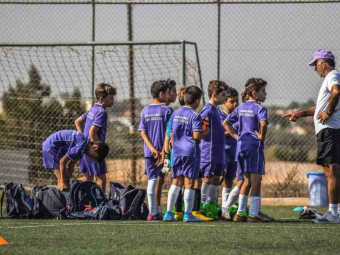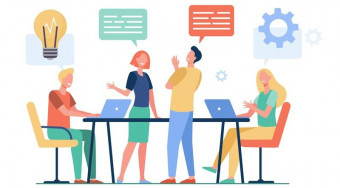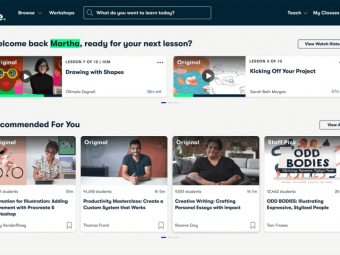Collaboration And Emotional Intelligence
Tags: Emotional Intelligence
Determine how to build more collaborative relationships using your emotional intelligence.
Last updated 2022-01-10 | 4.5
- Determine why a collaborative approach is beneficial in teamwork- Recognize why collaboration is underpinned with good emotional intelligence
- Evaluate ways to work with the principles and characteristics of collaboration - what works best
- when and where
What you'll learn
* Requirements
* You should have an interest and understanding of emotional intelligence but no prior knowledge and experience is needed to benefit from the course.* A keenness to identify and understand how to work collaboratively with others towards shared goals.
* An interest in how interactions with other people work and how to build them more effectively.
* You should have a willingness to complete the practical activities to grow and develop your emotional intelligence skills
Description
Collaboration frequently occurs in the workplace where people come together to cooperate and work on a strategic project in order that they can accomplish a common goal. It is simply teamwork taken to a higher level and has become a more productive way of doing things.
Most often collaboration happens within fairly small teams - functional teams, time-limited project teams or cross-functional management teams.
In effective collaboration, all people involved use their emotional intelligence well to balance emotional needs with their thinking, build authentic relationships and make good quality decisions on behalf of the organisation. Whether working with others one-to-one, in small groups or large teams, there is exemplary communication with empathy that engages hearts and minds. This occurs at all levels of the organisation.
This course is about collaborating with others in ways that will help you to communicate more efficiently as you work to understand and work with differences that lead to effective collaboration. In addition, the skills, processes and tools taught in this course can bring value to other aspects of your life.
People often talk about positive and negative emotions. This is not that helpful as emotions cannot really be labelled in that way. The course also covers the myths around positive and negative emotions and why this terminology is not appropriate when working to understand emotions and emotional intelligence in the workplace.
The course covers all aspects of collaborative working focusing on win-win collaboration where everyone benefits. The characteristics, principles and modes of collaboration are examined to give you a much broader insight into getting the best from collaboration.
The course, also, covers trust and how you can build trust as you work together with others.
Behavioural styles are reviewed looking at the strengths and liabilities of each. You get the opportunity to complete a questionnaire that will give you an insight to the behavioural style that you prefer to use with the chance to explore how your style can help and how it can hinder collaboration. Completing this practical activity will enable you to how to use your behavioural preferences and style to better effect when collaborating within a project.
This course is a standalone course for anyone interested in understanding collaboration at work and how to get more from collaborative relationships. It compliments other courses that explore emotional intelligence in more depth.
By completing this course, you will be able to
Determine why a collaborative approach is beneficial in teamwork
Recognize why collaboration is underpinned with good emotional intelligence
Evaluate ways to work with the principles and characteristics of collaboration - what works best, when and where
Explain the various modes that can be used in collaboration
Assess your own collaborative style and how this helps or hinders you in collaborative working
Identify strategies and ideas about how to collaborate more effectively
Manage work with multi-disciplinary teams at all levels within an organisation
Explore how to use mindfulness techniques to run collaborative meetings more effectively
Recognize how to use emotional intelligence to collaborate with others and build emotional bonds
You'll receive all the information that you need and will be coached using loads of practical hints that you can use straight away.
The course is made up of a series of lectures and contains comprehensive course notes. There are a series of interactive exercises that involve some activity with other people and some reflection.
PLEASE NOTE - This course is NOT for you if you are not prepared to work through the practical activities that make up a fundamental part of the course. Collaboration cannot be developed just by watching the video lectures. It requires you to do some reflective thinking, to get some feedback and to discuss your development with others. I'm afraid that you won't get the best from the course unless you are prepared to do this.
There are SEVEN practical activities included within the course that are designed to help you understand collaboration and how you can improve the way in which you work with other people towards shared goals All of them require you to engage with your collaborative team and do some work outside of the course.
The course is being continually refined and updated to ensure it remains current and relevant. Feedback is always welcome.
All PDFs are Section 508 / ADA Accessibility compliant.
All videos are high definition recorded in 1080p.
All videos have grammatically correct English captions.
Latest update - November 2021
Who this course is for:
- This course will support the development of your emotional intelligence. It will be of interest to you if you are looking to develop collaborative relationships, work towards win-win solutions and ways to interact with others effectively.
- This course will help you if you are regularly involved in collaborative teamwork
- This course will be of interest to you if you are interested in developing your collaborative skills
Course content
8 sections • 59 lectures
Introduction to the Course on Collaboration and Emotional Intelligence Preview 02:25
This introduction gives a brief overview of the course on Collaboration and Emotional Intelligence.
Details about this Course on Udemy Preview 03:47
This lecture gives you details about this course on the Udemy platform.
To make the course more fun, there are details of a specific practical activity - a competition - that will help you to work towards completing the course. Look for the letters that make up the word UDEMY that are hidden in some of the lectures to win a valuable prize. (No, it's not free access or a discount code for another course!)
The Learning Outcomes of the Course Preview 01:34
A look at the learning outcomes for the course.
Practical Activity: Managing Collaboration Preview 00:16
Before we start the course, here is a practical activity that encourages you to think about why you are taking the course and what you want to get from it.
How Taking a Different View on Team Working can Make a Big Difference Preview 02:52
Some people have certain views about working in a team whilst others see things from a different perspective.
Giving and Receiving Feedback in Collaboration Preview 07:27
This lesson looks at giving and receiving feedback in collaboration and how it is linked with emotional intelligence.
Tips to Develop your Emotional Intelligence in Collaboration Preview 04:37
Here are five questions that you should ask yourself in every collaboration, especially in challenging situation. These will help you to develop your emotional intelligence.
Practical Activity - Assess your Collaborative Competencies Preview 00:06
This practical activity helps you, through feedback, to assess your competencies in collaborative relationships.
The Role of Emotional Intelligence In Collaboration - Learning Outcomes Preview 00:53
This video gives you an understanding the learning outcomes covered in this module on emotional intelligence.
Defining Emotional Intelligence Preview 03:56
An overview of emotional intelligence giving you a definition and the meaning of emotional intelligence.
What is the Difference Between EI and EQ? Preview 03:33
You maybe confused about the terms EI and EQ and how the two seem to be readily interchanged. This lesson helps to give a distinction between the two.
Frequently Asked Questions (FAQs) about Emotional Intelligence Preview 00:20
Answers to a series of Frequently Asked Questions about the subject of emotional intelligence.
Insights into Emotions Preview 02:07
This lecture gives an insight into emotions and what they mean.
Emotional Intelligence at Work Preview 06:05
Emotions are experienced and expressed readily at work. This lecture investigates how emotions can be used intelligently at work.
The Myth about Positive and Negative Emotions Preview 07:05
People often talk about positive and negative emotions. This is not that helpful as emotions cannot really be labelled in that way. This lesson looks at why labelling emotions as positive or negative can be unhelpful.
Working with the Emotional Climate Preview 03:05
This lecture explores how to work with the emotional climate by assessing the level of emotional engagement and the level of emotional management.
Running Virtual Meeting with Emotional Intelligence Preview 02:52
Virtual meetings are now more common place. This lesson gives a useful tip around how to run virtual meetings using emotional intelligence.
Introducing the Working Practice of Collaboration Preview 03:59
This lecture introduces collaboration and looks at how assertiveness and cooperativeness work together.
Why Win-Win Collaboration is Important Preview 06:10
This lecture looks at why character, relationships and agreements are fundamental to collaboration and looks in more detail at win - win collaboration.
Emotional Intelligence and Win-Win Collaboration Preview 01:15
How emotional intelligence relates to collaboration, particularly win-win collaboration.
Workplace Collaboration Preview 04:15
This lecture investigates what workplace collaboration is all above and considers collaboration in different ways.
Why Collaborate and When to Collaborate Preview 02:51
This lecture looks at the reasons for collaborating - when and why collaboration works.
The Principles and Characteristics of Collaboration. Preview 03:17
This lecture covers the principles and characteristics of collaboration that everyone should adhere to.
The 3 Levels of Collaboration Preview 02:50
The levels of collaboration are how the team is set up through the structure and the effort to get the best way of working together.
The Ground Rules for Collaboration Preview 01:38
There are a number of factors to consider before collaborating with other departments that will increase your chances of success and avoid issues arising later on. Here are the ground rules for collaboration.
The Modes of Collaboration Preview 03:05
Consideration should be given to the modes of collaboration - the time and the place where collaboration occurs. The modes require different approaches.
The Advantages of Collaboration Preview 01:47
This lecture reviews the advantages of collaboration.
The Disadvantages of Collaboration Preview 01:35
This lecture reviews the disadvantages of collaboration.
An Overview of Some of Difficulties with Collaboration Preview 02:37
Collaboration may not always run smoothly. There may be issues inside the collaborative team and outside that may hinder progress.
Practical Activity - Collaboration within your Organisation Preview 00:17
This practical activity helps you to review the role of collaboration with your current working environment.
Emotional Intelligence and Collaboration Quiz
Conflict and Trust in Collaboration - Factors and Questions to Consider Preview 02:48
This lecture looks at conflict and trust in collaboration. It covers the factors that you need to consider that will impact upon the conflict and developing trust.
The Important Role of Trust Preview 04:00
In this lecture we look at trust and determine why it is important in collaboration.
The Trust Equation Preview 03:33
Trust can be represented by an equation. It consists of four interrelated factors - three combine to increase trust whilst one can diminish trust.
Building Trust using an Emotional Bank Account Preview 04:54
Stephen R. Covey and Stephen M. R. Covey (father and son) have both produced seminal models on trust. This lecture reviews both models and looks at ways that you can work to build trust in relationships.
Practical Activity - Your Emotional Bank Account Preview 00:20
This practical activity encourages you to think about the trust that you have in relationships in your personal life and at work.
If you are going to get the best out of this course, it is important that you complete this exercise!
(I know that it is very easy to ignore this but you will not be able to assess and build trust from just watching the video lectures!)
The Four Behavioural Styles in Collaboration - Learning Outcomes Preview 02:05
The introduction to this part of the course looking at behavioural preferences with the learning outcomes.
Practical Activity - Assess your Behavioural Style Preview 00:17
This Practical Activity gives you the chance to determine your behavioural style and, along with the rest of this Section, will help you to understand your approach to collaboration better.
If you are going to get the best out of this course, it is important that you complete this exercise!
(I know that it is very easy to ignore this but you will not be able to fully assess your behavioural style from just watching the video lectures!)
The Importance of Behavioural Flexibility Preview 02:53
This lecture looks at how my attitude and behaviour influences your attitude and behaviour and the cycle of behaviour that follows. It, also, looks at communication.
William Moulton Marston's Model of the Behavioural Expression of Emotions Preview 02:13
American psychologist and writer William Moulton Marston, in his 1928 book Emotions of Normal People introduced the prototype of the DISC profiling technique: a pair of axes producing a set of four interconnected factors. Marston originally called these four factors Dominance, Inducement, Submission and Compliance, though 'Inducement' and 'Submission' now carry the more meaningful modernised names of Influence and Steadiness.
It was during the 1940's that Marston's profiling technique came to prominence, when it was adopted by the U.S. military to help in recruitment during the Second World War. Over the following decades its simplicity and flexibility meant that it became more and more widely used across the world as a way of understanding behaviour. It is particularly useful in understanding people's approach to working in teams and in collaboration.
The High Dominance Behavioural Style Preview 02:30
High Dominance has a clear idea of their ambitions and goals, as well as the directness and forcefulness to achieve those goals. It also means that people like this will tend to have a competitive attitude, and they will generally follow their own ideas rather than work co-operatively with others.
This lecture reviews the High Dominance behavioural style with particular reference to collaborative team work with some do's and don'ts when working with this style.
The High Influence Behavioural Style Preview 03:20
High Influence thrives on the attention and approval of other people, and they're more motivated by praise and appreciation than most other types. Despite their outgoing attitude, they're often unwilling to risk causing offence, and they'll often avoid possible confrontations. In other words, while High Influence is socially confident, they tend not to be particularly assertive or forceful.
This lecture reviews the High Influence behavioural style with particular reference to collaborative team working with some do's and don'ts when working with this style.
The High Steadiness Behavioural Style Preview 03:17
High Steadiness is consistent and reliable in their approach. They prefer to operate in situations that follow established patterns, and to avoid unplanned developments. Because of this, people with High Steadiness tend to be quite resistant to change, and will take time to adapt to new situations.
This lecture reviews the High Steadiness behavioural style with particular reference to collaborative team working with some do's and don'ts when working with this style.
The High Compliance Behavioural Style Preview 03:12
High Compliance likes to have a clear idea of their role, and what's expected of them, so they are far more motivated in situations that are clearly regulated and planned. In general, High Compliance is not independent by nature, and will prefer not to be left to make decisions or take actions without the support of others.
This lecture reviews the High Compliance behavioural style with particular reference to collaborative team working with some do's and don'ts when working with this style.
Emotional Intelligence, Collaboration and the Behavioural Styles Preview 00:09
Download this poster that gives insights into how each behavioural style behaves in a collaborative relationship when they are being emotionally intelligent.
It, also, shows how each style behaves in a collaborative relationship when they are not being emotionally intelligent.
The Ideal Behaviours for Ideal Interactions with Each Behavioural Style Preview 04:43
DISC works by measuring four fundamental factors in a person's behaviour, and using those four factors to describe their personality.
This lecture looks at how you can adapt your behaviour in more valid and reliable ways. It, also, covers the ideal behaviours for you to demonstrate at work irrespective of your preferred style.
Do's and Don'ts of each Behavioural Style Preview 00:06
A summary booklet for you to download that gives some hints and tips when working with each of the four behavioural styles.
Practical Activity - Behavioural Styles and Collaboration Preview 00:29
An activity to determine the behavioural style(s) of everyone in your collaborative team.
Using Behavioural Styles to Build Collaborative Relationships Preview 03:12
This lecture looks at using DISC to build collaborative relationships.
Behavioural Styles - Learning Review Preview 01:46
This video concludes the module on DISC behavioural Styles with a short learning review.
Working with Behavioural Styles
This quiz is designed to test your knowledge of behavioural styles in collaboration.
Mindfulness and Collaboration Preview 03:48
Mindfulness leads to better collaboration. This lecture investigates what being mindful in collaboration is all about.
Mindful Meetings Preview 01:55
Meetings are a key part of collaboration. This lecture explores techniques that use mindfulness to improve collaborative meetings.
Facilitating Collaborative Meetings Considering Preferences Preview 02:17
This lecture focuses on how to facilitate meetings by considering what each of the DISC preferences are looking for through the collaboration.
Further Considerations around Running Collaborative Meetings Mindfully Preview 02:48
Finally, here are some further points to consider around running collaborative meetings more mindfully.
Practical Activity - Learning Review Preview 00:20
This is a practical activity to conclude the course. It requires you to consider your goals and objectives for taking the course that you set for yourself at the beginning of the course.
Review of the Course on Collaboration and Emotional Intelligence Preview 02:45
A brief overview of the learning takeaways from the course on collaboration and emotional intelligence.
How to Access your Udemy Certificate Preview 04:03
This video will help you if you are having issues accessing your Certificate of Completion.
Bonus Lecture Preview 03:40
Free stuff and special offers.








 This course includes:
This course includes:
















